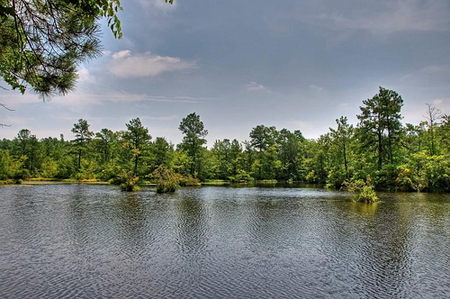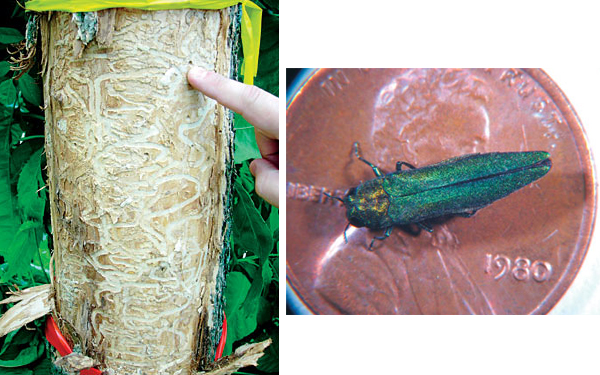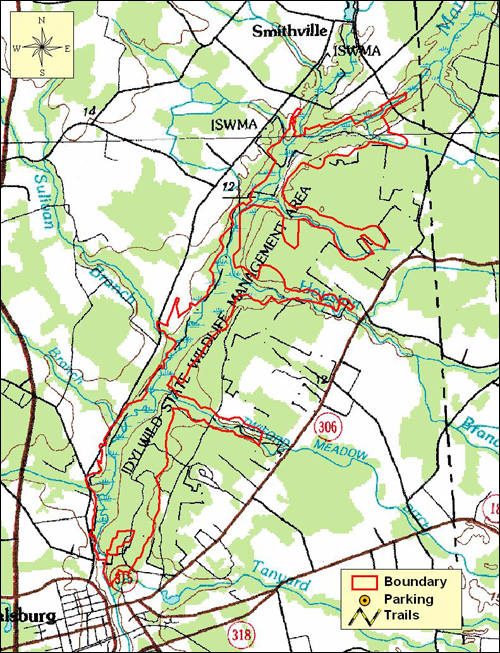Idylwild, Caroline County
 Along the Marshyhope River, a complex of upland sand ridges and high quality streams form the Idylwild Natural Area. These 10,000 year old sand ridges, formed during the Pleistocene Epoch, now support a diverse assortment of plants and animals including the only population of the Endangered Coastal Plain blue-eyed grass (Sisyrinchium fuscatum) in Maryland. In addition to the blue-eyed grass, over a dozen other rare, threatened and endangered species, such as the tiny swamp darter (Etheostoma fusiforme), make their home at the Idylwild Natural Area. Lucky visitors may catch a glimpse of the shy common gray fox as it hunts for small animals. These unusual foxes are one of only two canine species in the world that can easily climb trees! The slow, shallow waters at Idylwild create a haven for fish, amphibians, and dragonflies like the large bar-winged skimmer. The small Houston Branch and Twiford Meadow Branch drain into the Marshyhope River, creating excellent canoeing and kayaking opportunities through impressive stands of green and pumpkin ash.
Along the Marshyhope River, a complex of upland sand ridges and high quality streams form the Idylwild Natural Area. These 10,000 year old sand ridges, formed during the Pleistocene Epoch, now support a diverse assortment of plants and animals including the only population of the Endangered Coastal Plain blue-eyed grass (Sisyrinchium fuscatum) in Maryland. In addition to the blue-eyed grass, over a dozen other rare, threatened and endangered species, such as the tiny swamp darter (Etheostoma fusiforme), make their home at the Idylwild Natural Area. Lucky visitors may catch a glimpse of the shy common gray fox as it hunts for small animals. These unusual foxes are one of only two canine species in the world that can easily climb trees! The slow, shallow waters at Idylwild create a haven for fish, amphibians, and dragonflies like the large bar-winged skimmer. The small Houston Branch and Twiford Meadow Branch drain into the Marshyhope River, creating excellent canoeing and kayaking opportunities through impressive stands of green and pumpkin ash.
The Idylwild Natural Area is part of the Marshyhope Creek watershed. The ancient sand ridges found within the Natural Area are the northernmost late Pleistocene sand ridge deposits on the Delmarva Peninsula. A mixture of pines, oaks and heath shrubs can be found in the dry, sandy soils. This nearly 1,500 acre tract is part of the Idylwild Wildlife Management Area and is managed by the Maryland Department of Natural Resources Wildlife and Heritage Service.

Delicate Darter

Usually less than 2-inches long, the swamp darter is State-listed as In Need of Conservation. Although most darters thrive in clear, swift riffles and streams, this species inhabits slow-moving streams and ponds with dense aquatic vegetation and detritus, and often with acidic conditions. Its camouflage helps hide it from predators as it hunts for tiny insects and other invertebrates. At least six species of rare freshwater fish are found within and near Idylwild Natural Area.
A Green Menace

The vast forests of green and pumpkin ash along the Marshyhope River are threatened by the tiny yet very destructive emerald ash borer (EAB). EAB is an invasive beetle from Asia that is decimating almost all ash that it encounters. Millions of ash in the central and northeastern United States have succumbed to this beetle and some ecologists consider it a more serious threat than the ubiquitous, non-native gypsy moth. Emerald ash borer larvae tunnel through the tissues responsible for food and water distribution within a tree, causing the ash to starve to death. While EAB has not been found on the Eastern Shore as of 2012, it is only a matter of time before it colonizes along the Marshyhope.
 Click here for a Print Version of this map.
Click here for a Print Version of this map.
Directions
From the Chesapeake Bay Bridge: Head east on US 50 and south about 16 miles to MD 404. Turn left (east) onto MD 404 and continue nearly 20 miles to MD 313. Turn right (south) and proceed about 10 miles to Federalsburg. Turn left onto Bloomingdale Avenue; follow it 1 mile to MD 306 (E. Central Ave) and turn left. This soon becomes Houston Branch Road. Access is available via 10 parking areas surrounding the property.
Special Note: Idylwild Wildlife Management Area is used seasonally by hunters


Driving directions and aerial views open with Google Maps. For the aerial view button, if an aerial view does not open by default, click on the Satellite icon in the upper right corner and Google Maps will switch to an aerial view of the Natural Area.

Acknowledgments
Scenic View of Idylwild. Photo by: Richard Orr
Wildlife Collage One: (left to right)
Pumpkin ash grows on sites that remain wet for much of the year and, as a result, the trees develop enlarged bases, similar to those of bald cypress. Photo by: Christopher Tracey, PNHP
Common gray foxes are equally at home on the ground or in trees.Photo by: USFWS
Bar-winged skimmers busily hunt and patrol their territories in late spring and summer. Photo by: Richard Orr
The swamp darter can easily blend in with its surroundings. Photo by: Dave Neely
Wildlife Collage Two: (left to right)
A green ash tree killed by emerald ash borer beetles. Infested trees show clusters of D-shaped exit holes in the bark, made by the adults as they emerge. Beneath the bark are rows of serpentine tunnels made by the larvae as they feed. Infested trees may die in as �little as 1-3 years. Photo by: Wikimedia Commons
An emerald ash borer sitting on the head of a penny. Photo by: Wikimedia Commons